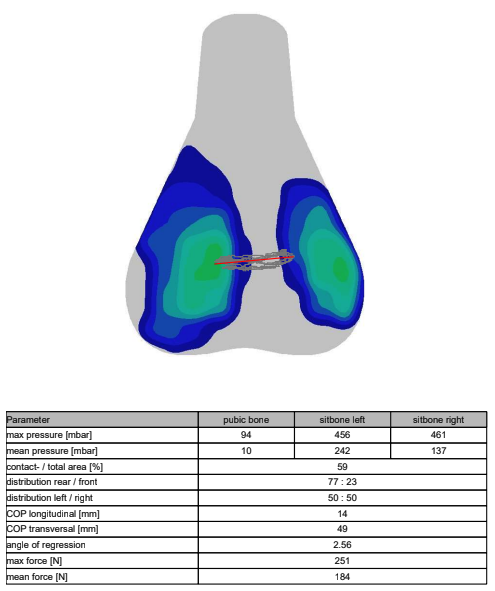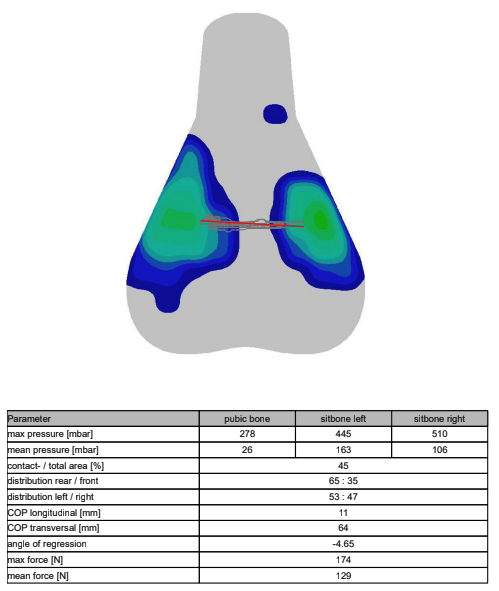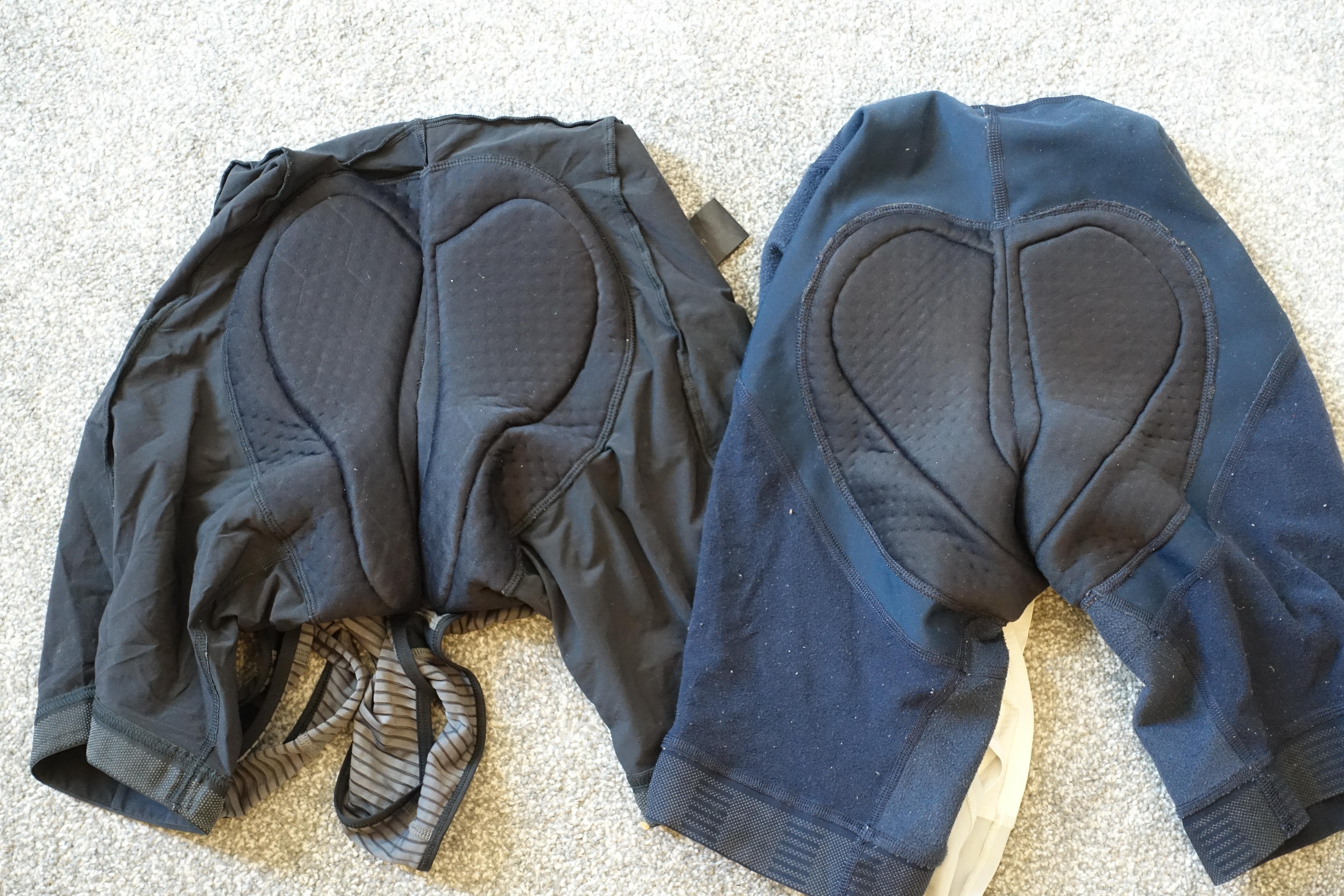
Having pulled together our guide to the best cargo bib shorts, as well as having a hand in our even bigger overarching guide to the best cycling shorts, I am always at pains to point out that they are a very personal item. I stop short of recommending one chamois specifically over another as even among my colleagues in the small Cyclingnews tech team, there is a noticeable variety between what we each like to ride.
This, though, is quite hard to quantify. It might feel right, but I want to find out how much difference shorts actually make.
I am in the fortunate position in that I have a lot of bib shorts at my disposal. There’s a box under my desk with at least 35 pairs, from all manner of brands across numerous pricepoints, and so I took as many as I could carry on my back to my go-to bike fitter, Jon Wild of Pedalling Perfection.
Not only is Jon an excellent bike fitter, and even more curious than I am about how bike products affect biomechanics and comfort, but he also has a saddle pressure mapping pad that allows us to see, in data terms, how much difference a pair of bib shorts makes to your comfort over another.

Using this, we have been able to measure a whole host of things and compare not only the differences between different cycling shorts from both different brands, and different models within the same brands, but directly compare the difference between changing saddles. We were also able to understand the impact that changing your shorts can have on certain aspects of your bike fit, such as effective saddle height.
Due to time constraints, I chose a shortlist of 15 pairs of cycling shorts, some of which I know I like, others I haven’t got on with, and a couple of multiples from the same brand.
I wanted to represent a good spread of brands, use cases - some race-oriented, some with a bikepacking/gravel focus - and price points. For the sake of openness and to show the variety on test, I have listed the shorts we tested below, but I have brand-anonymised the actual results.
I do not wish to suggest that based on my data, one particular set of shorts is ‘the best’, potentially leading people astray in their own choices. Nor do I wish to unfairly tarnish any particular pair as ‘the worst’. Remember, they're an extremely personal item.
Sign up to the Musette - our subscriber-only newsletter
Finally, it must be said that I have my own personal anatomical quirks. Thanks to a back injury I have a slightly wonky pelvis, so my left/right pressure split is exaggerated somewhat. As ever, your mileage may vary.
Before we get into it, though, a quick interlude to say this content isn't sponsored. It was made possible solely and entirely by our paying subscribers. We bought or borrowed all equipment used in the test, and our bike fitter's time was offered free of charge - a huge thank you to him for that.
The shorts on test
In reverse alphabetical order, the shorts I selected for testing were:
- Universal Colours Merino (now discontinued)
- Rapha Core Cargo
- Rapha Cargo
- Rapha Pro Team Winter
- Castelli Nano Flex
- Sportful Fiandre NoRain
- POC Rove Cargo VDPs
- Pearl Izumi Expedition Pro
- Pactimo Range Cargo
- Pactimo Aero
- Maap alt_road Cargo
- Gobik Ultralight
- Endura GV500
- Assos Equipe RS Winter
- 7mesh Cargo

Testing protocol
In essence, the test is marvellously simple; sit on the pad, pedal for a short duration (15 seconds or so), and a visual output of the pressure is created, along with hard values for the maximum and average pressure on the right and left sit bones and the pubic bone, along with a left/right balance figure as a pair of percentages.
The pad, for those curious, is from a company called gebioMized, which supports Ineos Grenadiers, as well as the Canadian and New Zealand national cycling federations.
In order to keep things consistent, a few variables did need to be controlled for though. I used the same hand position throughout so as to not impart any greater or lesser angle of rotation of my pelvis. To best represent ‘normal’ riding, this position was hands on the hoods.
The bike was set up on a Wahoo Kickr Rollr, and I kept the same cadence and used the same gear through all the tests. A variable gear would have meant I was pushing more force through the pedals at lower cadences, potentially unloading my sit bones to an unknown degree. And vice versa at higher cadences.
We ran a test on each of the 15 chosen bib shorts before swapping from a saddle I like, a Selle Italia SLR Superflow in this case, to one I know I don’t get on with, a Fizik Terra Argo, so that any change in saddle position wasn’t an influence on the tests. The saddles were aligned with the same setback so as to remove that variable as much as possible.


Results
Here are two tables - one for each saddle - showing the maximum pressure experienced (measured in millibars) for each of the 15 pairs of shorts on the left and right side of the saddle.
Raw data is hard to make sense of, so a much easier way to visualise the differences is from the image output of the pressure I experienced using each of the different shorts. Again, they're grouped by saddle, first the SLR Superflow and then the Terra Argo.
Blue is good, turquoise is fine, green is less good, and yellow is decidedly not good.
Selle Italia SLR Superflow















Fizik Terra Argo















Conclusions
So what does this data actually tell us? I've spent some time analysing the results and teased out some trends and some conclusions, which are explained below. I have created graphs to try and help you interpret the data more easily.
'Good' saddle versus 'bad' saddle

Simply plotting maximum left sit bone pressure against maximum right sit bone pressure on a scatter plot allows us to draw out some clear, high-level conclusions. Colour coding for each saddle clearly shows that the difference in maximum pressures between the various pairs of shorts is far greater with a nominally bad saddle compared to a nominally good one. The data is far more spread out for one versus the other.
While there is some limited overlap between the datasets, the shorts more or less all fared better with a good saddle than with a bad one. The very best of the shorts with a poorly fitting saddle only get you as comfortable as the very worst pair of shorts with a saddle that suits you. To put it another way, if you want to improve your comfort on the bike, finding a saddle that fits you properly is a substantially more appropriate first step.
I did graph the average pressures, but they aren’t hugely useful as a metric. If you’re riding on a saddle where your pelvis is rocking a lot you’re effectively totally unloading one side, which can artificially lower the average. What with my slightly wonky pelvis too, it’s best not to try and draw any realistic conclusions from this data set.
Shorts from the same brand

A mantra that is often touted, sometimes by me, is that if you’ve found a pair of shorts that you get on with then you should at least stick within the brand to get a more consistent experience. Highlighting shorts from the same brand on the original scatter graph shows that you’re more likely to have a similar experience within the same brand if you’re on a saddle that suits you, versus one that doesn’t. The variability of pressure values on a poorly fitting saddle is far greater.
Because there’s only one brand that is represented by a group of three - Rapha - I’m going to suspend my brand anonymity for a second because if you wanted to work it out, you could. Two of the three pairs were bikepacking/gravel oriented (both cargo models), and the other was a high-tempo, race pair. The clustering for the Rapha shorts clearly shows two shorts are very similar, with one slightly further out, at least with the SLR Superflow.
Ignoring the Argo data, the two Rapha shorts clustered right next to each other were the two more premium offerings, the Cargo, and the Pro Team Winter. Digging them all out reveals that both the Cargo and the Pro Team Winter share an identical chamois pad that differs from that used in the Core Cargo. This is heartening, but it also shows that (with the usual stuck record caveat of ‘with a saddle that suits you’) while shorts from the same brand may not give similar results, shorts with the same chamois pad should.
Just to confirm this, the other brand with multiple shorts featured, Pactimo, has different pads in the two shorts on test.

Do my own preferences tally up with the data?

In testing so many shorts out it’s impossible not to have favourites and ones you like to steer clear of unless all the others are in the wash, which is nearly impossible to achieve with over 30 pairs in the house. While all of us here at the tech team take pride in putting our personal biases aside when testing things, I was curious to see if my own were borne out in the data.
In this graph, I’ve highlighted in black those shorts which I tend to leave at the back of the cupboard, and those in green are my favourite pair.
My biases are a mixed bag. My favourite pair of shorts was the best on test on a bad saddle, but on the same saddle, my least favourite pair of shorts ran it pretty close. On the flip side, the gap between my favourite and least favourite pair of shorts was greater with the SLR saddle, and my least favourite pair of shorts did perform third worst, but my favourite was still somewhere in the middle.
I feel somewhat vindicated, but these subconscious preferences are borne out of riding them on different rides, different terrain, and often different bikes. Taking this into account I’m broadly pleased on the discerning nature of my derriere, and I think doing back-to-back tests of each pair on the same bike on the same route with the same saddle, I would be able to improve this.
In any case, if you have a pair of shorts you really don’t like there’s every chance it’s the saddle you’re not getting on with.
Does price have an impact?

Highlighting the most expensive in yellow and least expensive in green shows that price does, to some extent, have an impact.
The impact seems greater if you’re on an unsuitable saddle, likely as cheaper shorts use cheaper foams in their pads which distribute pressure less well and vice versa, though with a saddle that suits you at the high end, it seems that there’s less of a correlation.
Some anecdotal conclusions
Cycling shorts aim to dissipate the pressure on your sit bones, but variations in chamois thickness from one pair of shorts to another can have a knock-on impact on your bike fit. The thicker the effective chamois (that is how thick it becomes when compressed under your weight) the higher your effective saddle height becomes.
We found during testing that some thick but softer chamois pads resulted in a lower effective saddle height than some thinner, firmer ones, but in any case, it was clear that changing shorts can have a noticeable impact on your effective saddle height, in much the same way as changing from a high-stack to a low-stack pair of shoes would.
If your saddle becomes too high, you're going to rock on your pelvis more, placing more pressure on each individual sit bone in turn through each pedal cycle as the other side unweights to compensate. While it's not necessarily realistic to change your saddle height each time you wear a different pair of shorts it's something that's worth paying attention to as a possible cause of discomfort.

Buy the right saddle first
After all this, the take-home message for me is pretty clear. While there are implications for price and brand loyalty, the key thing to take away from this is that if you’re finding yourself uncomfortable on the bike, it’s substantially more likely to be due to your saddle than your shorts, so before spending money on a new pair of shorts in the hope that this fixes the problem, go and get yourself something from our list of the best road bike saddles or the best gravel bike saddles that suits you. This is of course best done with the help of a bike fitter, but many shops will have demo saddles that you can try before you buy, and online stores have returns policies, so I encourage you to at least make use of these facilities.
The best cycling shorts can just about mask a bad saddle, but that’s no path to true posterior comfort, and if you go after ever more expensive pairs of shorts in an effort to relieve your discomfort you could easily end up spending more on shorts than you would on a new saddle and potentially even a short appointment with a bike fitter.
The good news though is that once you have a saddle that suits you, you can worry a lot less about chamois comfort and start to consider other factors. Price, fit, compression, pockets, breathability or insulation can all be much more important if you’re on a comfortable perch.
This also has implications for our ongoing reviews of cycling shorts. While chamois comfort is clearly a factor that we should consider, product testing of shorts should be undertaken on a saddle of known comfort so as to be sure that a poor saddle isn't throwing off the results. We can also give more prominence to other features of shorts as listed above, with the necessary caveat that this depends on you having the right saddle.
If you subscribe to Cyclingnews, you should sign up for our new subscriber-only newsletter. From exclusive interviews and tech galleries to race analysis and in-depth features, the Musette means you'll never miss out on member-exclusive content. Sign up now.







